
The Cook Islands is a self-governing island country in the South Pacific Ocean in free association with New Zealand. It comprises 15 islands whose total land area is 236.7 square kilometres (91 sq mi). The Cook Islands' Exclusive Economic Zone (EEZ) covers 1,960,027 square kilometres (756,771 sq mi) of ocean.
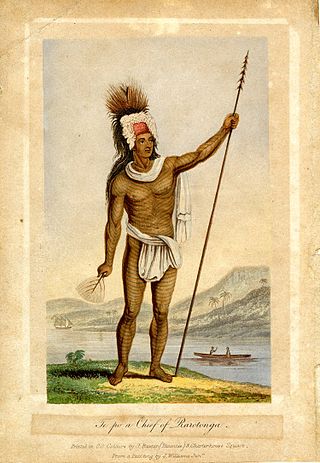
The Cook Islands are named after Captain James Cook, who visited the islands in 1773 and 1777, although Spanish navigator Alvaro de Mendaña was the first European to reach the islands in 1595. The Cook Islands became aligned to the United Kingdom in 1890, largely because of the fear of British residents that France might occupy the islands as it already had Tahiti.

The Union Jack, or Union Flag, is the de facto national flag of the United Kingdom. The Union Flag was also used as the official flag of several British colonies and dominions before they adopted their own national flags. The flag continues to have official status in Canada, by parliamentary resolution, where it is known as the Royal Union Flag.

Rarotonga is the largest and most populous of the Cook Islands. The island is volcanic, with an area of 67.39 km2 (26.02 sq mi), and is home to almost 75% of the country's population, with 10,898 of a total population of 15,040. The Cook Islands' Parliament buildings and international airport are on Rarotonga. Rarotonga is a very popular tourist destination with many resorts, hotels and motels. The chief town, Avarua, on the north coast, is the capital of the Cook Islands.

The flag of New Zealand, also known as the New Zealand Ensign, is based on the British maritime Blue Ensign – a blue field with the Union Jack in the canton or upper hoist corner – augmented or defaced with four red stars centred within four white stars, representing the Southern Cross constellation.

The national flag of Fiji was adopted on 10 October 1970. The state arms have been slightly modified but the flag has remained the same as during Fiji's colonial period. It is a defaced cyan "Blue Ensign", with the shield from the national coat of arms. It has remained unchanged since Fiji was declared a republic in 1987, despite calls from some politicians for changes.
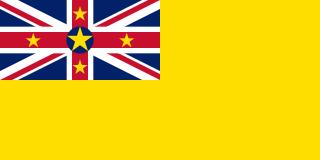
The flag of Niue was adopted on 15 October 1975. It consists of the Union Jack in the upper left corner with a star in the middle of the Union Jack and four stars forming a diamond around it. It is very unusual for a flag based on a British ensign design, in having not only a yellow background, but also a defaced (edited) Union Jack in the canton. It was designed by Patricia Rex, the wife of the then-Premier Robert Rex.
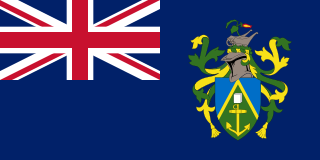
The coat of arms of the Pitcairn Islands is an official emblem of the British Overseas Territory of the Pitcairn Islands and was granted by royal warrant on 4 November 1969. The flag of the Pitcairn Islands, also an official emblem, consists of a Blue Ensign displaying the coat of arms and was granted on 2 April 1984.

The flag of Solomon Islands consists of a thin yellow diagonal stripe from the lower hoist-side corner, with a blue upper triangle and green lower triangle, and the canton charged with five white stars. Adopted in 1977 to replace the British Blue Ensign defaced with the arms of the protectorate, it has been the flag of Solomon Islands since 18 November of that year, eight months before the country gained independence. Although the number of provinces has since increased, the number of stars on the flag that originally represented them remained unchanged.

The coat of arms of the Cook Islands has a shield as its focal point. The shield is blue with fifteen white stars arranged in a circle, as found on the national flag, and is supported by a flying fish (maroro) and a white tern (kakaia). The helmet is an ariki head-dress of red feathers, symbolising the importance of the traditional rank system, and the name of the nation is on a scroll below the shield. The achievement is augmented by a cross and a Rarotongan club used by orators during traditional discourses, respectively symbolizing Christianity and the richness of Cook Islands' tradition, placed in saltire behind the shield.

Albert Royle Henry was the first Premier of the Cook Islands and the founder and first leader of the Cook Islands Party (CIP). First elected Premier in August 1965, he was unseated in the aftermath of the 1978 election after an electoral petition found he had committed electoral fraud. He was later stripped of his knighthood. In 2023 he was posthumously pardoned.

The flag of Australia, also known as the Australian Blue Ensign, is based on the British Blue Ensign—a blue field with the Union Jack in the upper hoist quarter—augmented with a large white seven-pointed star and a representation of the Southern Cross constellation, made up of five white stars. Australia also has a number of other official flags representing its people and core functions of government.
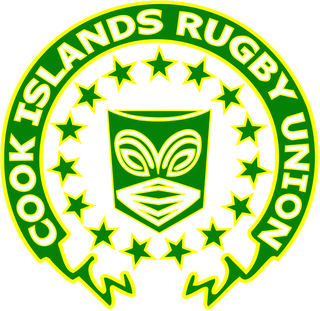
The Cook Islands is a third tier rugby union playing nation. They began playing international rugby in early 1971. Thus far, the Cook Islands have not made an appearance at any of the World Cups.

The flag of Ascension Island, part of the British overseas territory of Saint Helena, Ascension and Tristan da Cunha, was adopted on 11 May 2013. The flag is a blue ensign design, defaced with the coat of arms of Ascension Island.

The coat of arms of Samoa takes its inspiration from the United Nations, as New Zealand administered Western Samoa first as a League of Nations Mandate and then as a United Nations trusteeship until the country received its independence on 1 January 1962, as Western Samoa. Samoa was the first Polynesian nation to reestablish independence in the 20th century. The background is cross-hatched with a grid like the United Nations arms, most of the other elements are duplicated on the national flag.

The Kingdom of Rarotonga, named after the island of Rarotonga, was an independent kingdom established in the present-day Cook Islands in 1858. In 1888 it became a protectorate of the United Kingdom at its own request. In 1893 the name was changed to the Cook Islands Federation.

Rugby league is the national sport and most popular sport in the Cook Islands, with soccer and rugby union as the next most popular/played sports. In September 2009, the Cook Islands hosted the 2009 Pacific Mini Games. Cook Islands Sports National Olympic Committee is the official governing body of sport in the Cook Islands.

The Australian flag debate is a question over whether the Australian flag should be changed, particularly to remove the Union Jack from the canton, but also to possibly introduce a completely new design without the Southern Cross. Acknowledgement of the significance of the issues, and corresponding changes are required to reflect Australia's multicultural society, as well as to reflect Australia's immensely rich, and intricate and complex shared history.

Makea Takau Ariki was a sovereign of the Cook Islands. She was the ariki (queen) of the dynasty Makea Nui, one of the three chiefdoms of the tribe Te Au O Tonga on the island of Rarotonga.
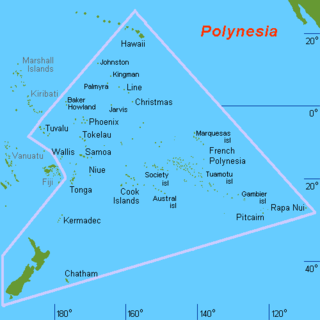
This is a gallery of current and historical flags of Polynesia.
 Flag of the Kingdom of Rarotonga between 1858 and 1888
Flag of the Kingdom of Rarotonga between 1858 and 1888 Flag of the Cook Islands Federation from 1893 to June 11, 1901
Flag of the Cook Islands Federation from 1893 to June 11, 1901






























